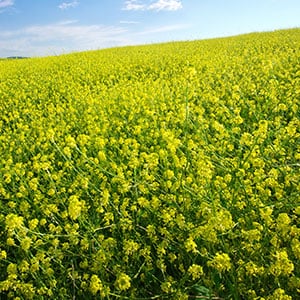Rapeseed is one of the most sought-after oil crops globally, holding a significant place in agriculture due to its high yield and versatile applications. This crop is used to produce vegetable oil for food, industrial, and biofuel production. Additionally, the meal and cake left after seed processing serve as valuable animal feed. In recent years, rapeseed has gained popularity in Russia, demonstrating good adaptability to various climatic conditions.
Rapeseed as a Crop
Rapeseed (Brassica napus) belongs to the Brassicaceae family. It is an annual or biennial plant with a robust root system and an erect stem reaching 1–1.8 meters in height. The flowers are yellow, arranged in racemes, and the fruit consists of pods containing small black or brown seeds.
There are two main types of rapeseed: spring and winter.
- Winter rapeseed is sown in autumn, overwinters in the field, and is harvested the following summer. This type is more productive but requires mild winters and consistent snow cover.
- Spring rapeseed is sown in spring. It is less demanding in terms of winter conditions but yields less than winter varieties.
Rapeseed thrives in temperate climates, preferring moderately warm summers and sufficient moisture. It is light-loving and relatively frost-resistant, especially winter varieties. In Russia, rapeseed is cultivated in central regions, the Volga area, the Urals, Altai Krai, and Siberia.
Cultivation Technology
- Soil Preparation
Rapeseed has high demands on soil structure and fertility. The best predecessors are cereals or legumes. The soil is loosened to a depth of 20–25 cm, weeds are removed, and the surface is leveled. Good drainage is essential, as the crop is drought-sensitive. - Sowing
Sowing times depend on the rapeseed type:- Winter rapeseed is sown in late summer or early autumn so plants can form a rosette before cold weather.
- Spring rapeseed is sown in spring when soil temperatures reach 5–6°C.
- Crop Care
Weeds must be controlled, as rapeseed competes poorly with them in early growth stages. Herbicides and inter-row cultivation are used for weed management. Mineral fertilizers—especially nitrogen, phosphorus, and potassium—are highly effective.
Ripening and Harvest Indicators
Readiness for harvest is determined by pod condition: they turn brown, and the seeds inside harden, becoming black or dark brown. Seed moisture at harvest should be 10–13%.
There are two main harvesting methods:
- Direct combining – Plants are cut and threshed immediately, used when crops mature uniformly.
- Swathing – Plants are first cut into windrows, left to dry for 5–7 days, then picked up and threshed. This method is used for uneven ripening or if pod shattering is a risk.
In central Russia, winter rapeseed is harvested from late July to August, while spring rapeseed is harvested from August to September. Delayed harvesting leads to yield loss due to seed shedding.
Storage Requirements for Rapeseed
Rapeseed seeds are prone to damage during storage, especially if moisture levels are too high. Before storage, they must be thoroughly cleaned and dried to no more than 8% moisture. Seeds should be stored in clean, dry, well-ventilated areas, protected from rodents and insects. Regular monitoring of temperature and humidity is crucial—poor storage conditions can lead to rapid spoilage, reduced germination, and loss of oil content.
Conclusion
Rapeseed's popularity continues to grow as it remains a strategically important crop for Russian and global agriculture. It is cultivated for oil, feed, and biofuel production.
Modern cultivation techniques, proper harvesting, and storage practices maximize rapeseed yields, ensuring its continued significance in crop production.
 5 min
5 min 1554 ppl
1554 ppl

